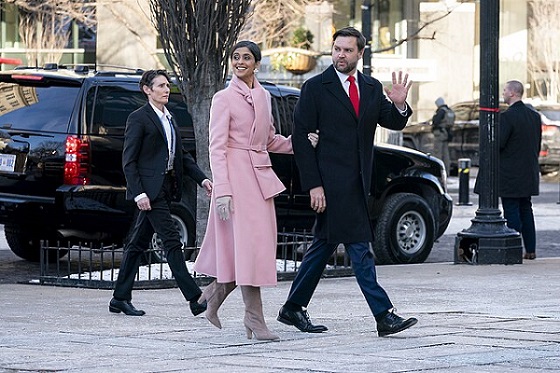International
Vice President Vance, Second Lady to visit Greenland on Friday

 MxM News
MxM News
Quick Hit:
Vice President JD Vance announced he will join Second Lady Usha Vance in Greenland on Friday, escalating the Trump administration’s focus on the island amid growing global interest and resistance from Danish and Greenlandic officials.
Key Details:
- Vance will join Usha Vance and U.S. officials already in Greenland, including National Security Adviser Mike Waltz and Energy Secretary Chris Wright.
- The trip includes a stop at Pituffik Space Base to assess Arctic security and meet with U.S. Space Force guardians.
- Greenland’s prime minister called the second lady’s earlier visit an “aggressive” move as Trump reaffirms his interest in acquiring the island.
Diving Deeper:
Vice President JD Vance confirmed Tuesday that he will accompany Second Lady Usha Vance to Greenland at the end of the week, intensifying U.S. engagement with the strategically located island that President Donald Trump has long said should be part of the United States. The visit reflects the administration’s ongoing efforts to strengthen America’s geopolitical presence in the Arctic and counter growing threats from adversarial nations seeking influence in the region.
“You know, there was so much excitement around Usha’s visit to Greenland this Friday that I decided that I didn’t want her to have all that fun by herself, and so I’m going to join her,” Vance said in a video posted to X, formerly Twitter.
The vice president said he will be visiting U.S. Space Force personnel stationed at Pituffik Space Base on Greenland’s northwest coast, where he will receive a briefing on security developments in the Arctic and inspect key infrastructure critical to American defense.
“A lot of other countries have threatened Greenland,” Vance warned. “Have threatened to use its territories and its waterways to threaten the United States, to threaten Canada, and, of course, to threaten the people of Greenland. So we’re gonna check out how things are going there.”
The second lady’s presence already drew a sharp rebuke from Greenland’s prime minister, who denounced the visit as an “aggressive” gesture amid renewed speculation that Trump may move to formally acquire the autonomous Danish territory. Despite the backlash, Usha Vance currently holds the distinction of being the highest-ranking U.S. political figure to visit Greenland since Trump returned to the White House as the 47th president in January.
In comments that will likely raise further diplomatic alarms in Copenhagen, Vance reiterated President Trump’s broader Arctic strategy, emphasizing the administration’s commitment to defending Greenland’s people—and the world—from neglect and external threats.
“And I say that speaking for President Trump,” Vance stated, “we want to reinvigorate the security of the people of Greenland because we think it’s important to protect the security of the entire world. Unfortunately, leaders in both America and in Denmark, I think, ignored Greenland for far too long. That’s been bad for Greenland. It’s also been bad for the security of the entire world. We think we can take things in a different direction.”
With national security adviser Mike Waltz and Energy Secretary Chris Wright already on the ground, the full weight of the Trump administration’s Arctic pivot is becoming increasingly visible. Whether Denmark and other NATO allies see the move as cooperative or confrontational remains to be seen—but for now, the United States is clearly asserting itself in one of the world’s most contested and overlooked regions.
Business
Some Of The Wackiest Things Featured In Rand Paul’s New Report Alleging $1,639,135,969,608 In Gov’t Waste


From the Daily Caller News Foundation
Republican Kentucky Sen. Rand Paul released the latest edition of his annual “Festivus” report Tuesday detailing over $1 trillion in alleged wasteful spending in the U.S. government throughout 2025.
The newly released report found an estimated $1,639,135,969,608 total in government waste over the past year. Paul, a prominent fiscal hawk who serves as the chairman of the Senate Homeland Security and Governmental Affairs Committee, said in a statement that “no matter how much taxpayer money Washington burns through, politicians can’t help but demand more.”
“Fiscal responsibility may not be the most crowded road, but it’s one I’ve walked year after year — and this holiday season will be no different,” Paul continued. “So, before we get to the Feats of Strength, it’s time for my Airing of (Spending) Grievances.”
Dear Readers:
As a nonprofit, we are dependent on the generosity of our readers.
Please consider making a small donation of any amount here.
Thank you!
The 2025 “Festivus” report highlighted a spate of instances of wasteful spending from the federal government, including the Department of Health and Human Services (HHS) spent $1.5 million on an “innovative multilevel strategy” to reduce drug use in “Latinx” communities through celebrity influencer campaigns, and also dished out $1.9 million on a “hybrid mobile phone family intervention” aiming to reduce childhood obesity among Latino families living in Los Angeles County.
The report also mentions that HHS spent more than $40 million on influencers to promote getting vaccinated against COVID-19 for racial and ethnic minority groups.
The State Department doled out $244,252 to Stand for Peace in Islamabad to produce a television cartoon series that teaches children in Pakistan how to combat climate change and also spent $1.5 million to promote American films, television shows and video games abroad, according to the report.
The Department of Veterans Affairs (VA) spent more than $1,079,360 teaching teenage ferrets to binge drink alcohol this year, according to Paul’s report.
The report found that the National Science Foundation (NSF) shelled out $497,200 on a “Video Game Challenge” for kids. The NSF and other federal agencies also paid $14,643,280 to make monkeys play a video game in the style of the “Price Is Right,” the report states.
Paul’s 2024 “Festivus” report similarly featured several instances of wasteful federal government spending, such as a Las Vegas pickleball complex and a cabaret show on ice.
The Trump administration has been attempting to uproot wasteful government spending and reduce the federal workforce this year. The administration’s cuts have shrunk the federal workforce to the smallest level in more than a decade, according to recent economic data.
Festivus is a humorous holiday observed annually on Dec. 23, dating back to a popular 1997 episode of the sitcom “Seinfeld.” Observance of the holiday notably includes an “airing of grievances,” per the “Seinfeld” episode of its origin.
International
Georgia county admits illegally certifying 315k ballots in 2020 presidential election

From LifeSiteNews
Approximately 150 ‘tabulator tapes’ tracking the votes of more than 300,000 early voters were not signed.
Fulton County, Georgia, has admitted to including 315,000 early votes in the disputed 2020 presidential election despite the fact that they were not properly certified according to state law.
State law demands that voting “tabulator tapes” that publish the recorded results of polling stations must be verified and signed by poll workers, but approximately 150 tapes tracking the votes of more than 300,000 early voters were not signed.
In a hearing before the State Election Board (SEB), an attorney for Fulton County said the county does “not dispute that the tapes were not signed.”
“It was a violation of the rule,” she said. “They shouldn’t have done it.”
“At best, this is sloppy and lazy. At worst, it could be egregious,” fired back Georgia SEB Member Janelle King. “It could have affected an election.”
The December 9 hearing was the result of election integrity activist David Cross, who filed a challenge with the board in 2022, alleging that Fulton County’s handling of early voting violated the state’s election rules.
“These are not clerical errors. They are catastrophic breaks in chain of custody and certification,” Cross said during the hearing.
“Because no tape was ever legally certified, Fulton County had no lawful authority to certify its advanced voting results to the secretary of state. Yet it did,” said Cross. “And Secretary [Brad] Raffensperger accepted and folded those uncertified numbers into Georgia’s official total without questioning them.”
“This is not partisan. This is statutory. This is the law. When the law demands three signatures on tabulator tapes and the county fails to follow the rules, those 315,000 votes are, by definition, uncertified,” said Cross.
Raffensperger, Georgia’s secretary of state, took to social media to discount the allegations.
“Georgia has the most secure elections in the country and all voters were verified with photo ID and lawfully cast their ballots. A clerical error at the end of the day does not erase valid, legal votes,” averred Raffensberger.
– Secretary Raffensperger on alleged procedural errors in Fulton County’s administration of the 2020 election.
— GA Secretary of State Brad Raffensperger (@GaSecofState) December 20, 2025
Meanwhile, Republicans took issue with Raffensperger’s denial of the seriousness of Fulton County’s procedural lapse.
Republican Lieutenant Governor Burt Jones ridiculed Raffensberger’s post.
“If only Georgia had an official responsible for preventing clerical errors that undermine election integrity,” said Jones, a candidate for Georgia governor.
“Is there anyone in Georgia who has that job, Brad?” asked Jones, his opponent in the state’s gubernatorial race.
If only Georgia had an official responsible for preventing clerical errors that undermine election integrity.
Is there anyone in Georgia who has that job, Brad? https://t.co/5v89jcPZwL
— Burt Jones (@burtjonesforga) December 22, 2025
“We just started peeling the layers back on this onion and it already stinks,” said U.S. House Rep. Mike Collins (GA-10). “Years later, when the truth finally comes out, Trump was right.”
“President Trump is owed a massive apology,” asserted Collins. “Turns out over 300,000 early votes in the 2020 election were illegally certified but still included in the final results.”
Collins said he is “tired of empty words from weak leaders. The people of Georgia demand action.”
President Trump is owed a massive apology.
Turns out over 300,000 early votes in the 2020 election were illegally certified but still included in the final results.
I’m tired of empty words from weak leaders. The people of Georgia deserve action. pic.twitter.com/pcCrdGFXVS
— Mike Collins (@MikeCollinsGA) December 20, 2025
In the 2020 election, Joe Biden narrowly beat out incumbent President Donald Trump by less than 12,000 votes in the Peach Tree State.
-

 Agriculture1 day ago
Agriculture1 day agoWhy is Canada paying for dairy ‘losses’ during a boom?
-

 Automotive2 days ago
Automotive2 days agoFord’s EV Fiasco Fallout Hits Hard
-

 Alberta1 day ago
Alberta1 day agoAlberta’s new diagnostic policy appears to meet standard for Canada Health Act compliance
-

 Alberta16 hours ago
Alberta16 hours agoHousing in Calgary and Edmonton remains expensive but more affordable than other cities
-

 Business15 hours ago
Business15 hours agoState of the Canadian Economy: Number of publicly listed companies in Canada down 32.7% since 2010
-

 Censorship Industrial Complex13 hours ago
Censorship Industrial Complex13 hours agoCanadian university censors free speech advocate who spoke out against Indigenous ‘mass grave’ hoax
-

 Bruce Dowbiggin17 hours ago
Bruce Dowbiggin17 hours agoHunting Poilievre Covers For Upcoming Demographic Collapse After Boomers
-

 Censorship Industrial Complex1 day ago
Censorship Industrial Complex1 day agoTop constitutional lawyer warns against Liberal bills that could turn Canada into ‘police state’






